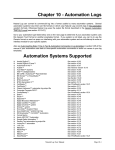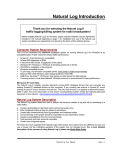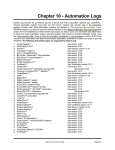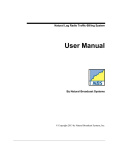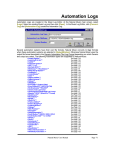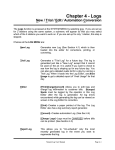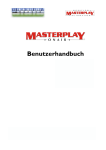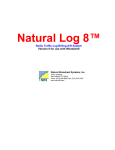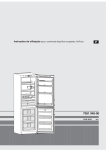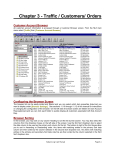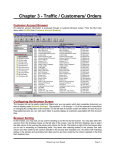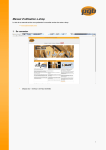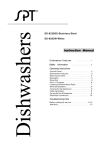Download Ch-12 Glossary - Index - Natural Broadcast Systems
Transcript
Natural Log Glossary of Terms Account Rep Natural log refers to "radio ad sales personnel" who work for the station as Account Reps. Accounts Receivable The unpaid amount customers owe you. Accounts Receivable Adjustment A transaction you enter in NL8 to reflect an increase [Debit] or decrease [Credit] in the amount a customer owes you other than a payment received or an invoice issued. This could be the result of a bad debt write-off, a trade-credit, or a debit to record a returned check. Accounts Receivable Aging Report This report shows the unpaid balance for each customer as of the report date. It does not show total sales, only the remaining unpaid balance. To report total sales, use the invoiced sales report under [Reports][Transactions]. Accounts Receivable Reconciliation Report This report shows the beginning balance, plus invoiced sales, less payments received, plus-or-minus adjustments, to show the end-of-period balance. Account Statement An account statement in NL8 shows all activity on a customer account within the specified period, including prior balances, payments, invoices, and adjustments. It does not show individual runtimes which are shown on invoices.See Account Statements. Adjacency This is a commercial avail that occurs immediately before or after some program. For example, this might be an item that must run immediately before or after the news. Most broadcasters charge extra for adjacencies. You can set up Stand-Alone avails for these items and you usually restrict the AvailTypes to prevent an advertiser who did not purchase an adjacency from being logged into that avail. Agency This is a person or company that places advertising on your station on behalf of a sponsor. They usually provide copy as part of the service they render to the advertiser. In exchange they are usually allowed an Agency Commission discount on the gross invoice amount. They collect the full amount from the advertiser and pay the station the net amount. Agency Commission This is the % commission of the Gross invoice amount allowed for an agency purchase. Gross minus Agency Commission = Net. Note: If other Discounts are given, the agency commission is based on the Discounted-Gross invoice amount. AlphaNumeric Data Field This is a data field in Natural Log 8 that can contain any combination of numbers, letters, and punctuation. Avails In NL8 Log Templates, any line with * on it. This indicates one item from a Broadcast Order may be scheduled into that slot. There are 2 types of avails, Commercial Breaks and Stand-Alone avails. Natural Log User Manual Page 12-1 Natural Log Glossary of Terms Avail-Types During log generation NL8 will only put ordered items into avail slots whose Log Template Avail-Type matches the Broadcast Order Avail-Type. Normally the Avail-Type in both NL8 Log Templates and Broadcast Order Lines should be Unrestricted! This means any item from the Broadcast Order can be logged into any avail slot within the order line's time window. The only time you use Avail-Types is when you want to force a particular customer's item into a particular avail slot or to reserve an avail slot for a particular type of ordered item [such as a program sponsorship or adjacency]. In that case the same Avail-Type must be entered on both the Log template and the Broadcast Order. See Avail-Types on Log Templates and Avail-Types on Broadcast Orders. Balance-Forward Account Statement This is a type of account statement in NL8 that lists a non-detailed beginning balance, new activity such as payments, invoices and adjustments, and en ending balance. It does not show individual runtimes which are shown on invoices. Also see Open-Item Account Statement. Please note that selecting these statement types does not change the internal record keeping of NL8. You can always switch between Open-Item and Balance-Forward statements for individual customers without any loss of data. Billing Cycle This controls the closing dates for a billing period and allows you to group invoices to be billed at different times. This may be Broadcast Month, Calendar Month, End-of-Schedule, Demand, Weekly, or Special1 through Special9. Book-Ends [Also known as Tops ‘n Tails] A term used to describe an advertiser that requests the very first avail in a commercial break and the very last avail in the same commercial break. Some advertisers use the Book-Ends approach to tell part of their advertising "story" in the opening of a commercial break, then complete it in the closing of the same commercial break. This type spot placement should command a large cost premium over regular spot placement. Broadcast Invoice An invoice in NL8 shows only the broadcast items run from a single broadcast order during the current billing period. It does not include any prior balances. See Account Statement and Broadcast Invoices. Broadcast Month This month starts on the Monday after the last Sunday of the prior calendar month and always ends on the last Sunday of the month. It will always have either 4 or 5 standard broadcast weeks. This is the month used by most advertising agencies. Broadcast month and standard broadcast month have the same meaning. Broadcast Orders Broadcast Orders are the means by which NL8 knows how you want to schedule broadcasts for a customer, how to invoice it, and the rules you want NL8 to follow when scheduling the broadcasts. Each Broadcast Order in NL8 results in a separate invoice. Calendar Month The month we normally think of starting on the 1st and ending on the 28th in February (except leap years), the 30th in April, June, September, and November, and the 31st in all other months. This is the month used by most non-agency accounts. Page 12-2 Natural Log User Manual Natural Log Glossary of Terms Charged Log This is a log that is a "final" log whose billable items have been attached to invoices. Charging the log can be done in either the Log Editor or Broadcast Billing sections of NL8. Charging the log is what causes the billable items on the log to be attached the customers' invoices. Before a log is charged the log's billable items do not show on invoices. After a Log is charged billable items show on the invoices but the log may no longer be edited from the Log Editor [but invoiced items can be edited from the Invoice Editor]. For this reason, logs should be charged only after they are reconciled [and corrected if needed] to accurately reflect what actually aired. Commercial Break In an NL8 Log Template, a group of avails in which more than one commercial item may run sequentially as part of a single break or stopset from regular non-commercial programming. This is designated on the Log Template with a ** on the first avail line and *^ on following avail lines so that there are as many lines starting with * as commercial items allowed in the break Co-Op This is a situation in which a manufacturer or distributor pays some or all of a local store's ad costs to advertise the manufacturers product. This usually requires the submission of invoices and affidavits showing the script actually run. See entering Co-Op scripts in Copy Manager and printing Co-Op script affidavits in order entry. Copy This is a single script or prerecoreded item to be scheduled in NL8. During order entry you just specify the exact CopyID of the individual piece of copy to be scheduled when that order line runs. This CopyID should exactly match the AudioCut ID (or Filename) within your automation system. See Automation CopyID Up to 20 alphanumeric characters used to uniquely identify a piece of copy in the NL8 system. This CopyID is attached to the order lines so NL8 knows which copy to schedule. This must exactly match the ID given the same audio cut in your automation system. Copy Schedule This consists of 2 or more individual pieces of Normal Copy and/or Packets, and/or Rotators. These items sequentially substitute for each other after the previous piece of copy expires. During order entry you just specify the exact CopyID of the Schedule itself to be scheduled when that order line runs. When NL creates the log, it will find the appropriate individual CopyID within the Schedule and schedule it. There is no limit to how many Copy items you can put in a Copy Schedule Credit Adjustment A decrease [Credit] in the amount a customer owes you other than a payment received. This could be the result of a bad debt write-off or a trade-credit. Date Selector When you click a date selection dropdown box, you'll see a calendar for picking the date. To select a date, use the arrows around the month to select the month, the arrows around the year to select the year, then click in the cell containing the desired day-of-month. You can also use the up arrow, down arrow, page-up [up month], and page-down [down month] keys on the keypad to navigate the calendar. To switch between Calendar Month and Broadcast Month display click the small button in the upper left corner of the dropdown display. You can set the default display type in Program Options. Natural Log User Manual Page 12-3 Natural Log Glossary of Terms Date Formatting NL8 prints dates on documents such as Invoices and Statements using the Windows date format and regional settings you designate in the Windows Control Panel. Debit Adjustment An accounts-receivable transaction you enter in NL8 to reflect an increase in the amount a customer owes you other an invoice being issued. This could be the result of a debit to record a returned check. Demand Billing Cycle Should almost never be used. This Billing Cycle tells NL8 to generate an invoice for this order only when the NL8 user specifically selects the order to be billed. Note: If you select All billing cycles in the Broadcast Invoices section, NL8 will generate an invoice once per calendar month for "Demand" Billing-Cycle orders. Discounted-Gross Invoice Amount This is the Gross invoice amount less Discounts-Allowed [before any commissions or trade credits are deducted and before taxes are added]. If there are any discounts allowed, agency commission is computed on the Discounted-Gross Invoice amount. Discounts-Allowed This is the % of the Gross invoice amount allowed as discounts other than agency commissions. Electronic Invoice Any non-paper method of delivering invoices. NL8 supports email pdf files as well as most of the popular broadcast electronic invoice clearinghouses. End-of-Month Closing The process to close an accounting period in NL8. This should only be done after all invoices have been issued for that period and all payments and adjustments received during the period have been posted. You cannot enter any transactions dated prior to the last date closed in NL8. This stops someone from messing up a previous A/R reconciliation. See end-of-month closing for more detailed information. End-of-Schedule Billing Cycle This Billing Cycle tells NL8 to generate an invoice for this order only at the end of the order run dates. Fill-Code on Log Templates This tells NL8 that the commercial break or stand-alone avail must be filled. See If-Used Fill-Code and Mandatory Fill-Code and Fill-Code Fill-Priority on Log Templates This tells NL8 the order in which to use commercial avails when generating a log. See Fill-Priority. Final Invoices This is the process in NL8 Broadcast Billing which finalizes, prints and post invoices to Accounts Receivable. Until process this is done, invoices do not show up in A/R. See Broadcast Invoices for more information. Page 12-4 Natural Log User Manual Natural Log Glossary of Terms Gross Invoice Amount This is the total of all charges on an invoice before any discounts, agency commissions, or trade credits are deducted and before any taxes are added. Also see discounted-gross invoice amount. If-Used Fill-Code on Log Templates This tells NL8 that the commercial break must be filled to the specified length [provided you entered a required length on the Log template] only if at least 1 item is logged within that commercial break. This is helpful for satellite network formats in which you must fill certain commercial breaks because the network does not cover them. Invoice An invoice in NL8 shows only the items run from a single broadcast order during the current billing period. It does not include any prior balances. See Account Statement. Invoiced Sales Report This report shows the invoiced sales for the report period. To get a report showing current customer balances see accounts receivable aging report. ISCI Industry Standard Coding Identification (ISCI) is a system for coding commercials established in 1970 and owned and operated by the American Association of Advertising Agencies. ISCI codes are eight characters in length - four alpha followed by four numeric, and are designed to have no spaces, hyphens or other characters (eg, ABCD1234). These identify the agency copy that was aired. Level Package Billing Every time an invoice is generated from an order with schedule lines from which at least 1 billable item was logged or the order has NO schedule lines, a specified flat amount is billed. Exception: If order status is HOLD and nothing was logged, no amount will be billed. Level Package Billing specified using Billing Basis on the Order entry screen. Local Spots These are spots carried and billed locally by the user of NL8 as opposed to network spots. Log Templates These are the basic logs that tell NL8 what each day's log should look like. It includes avails and commercial breaks where items from Broadcast Orders may be logged. Templates can also contain text to be printed on the log pages as well as automation commands. Every day of the week Monday-Sunday must have at least a Normal Daily Log Template. Special Date Log Templates are used only on a particular date in lieu of the Normal Daily Log Template for that day. You can also create Special Events Templates for programs such as sporting events. Each station in NL8 has its own set of Log Templates. See Log Template setup for more detailed information. Macros In NL8 a macro does not refer to any "Macros" you may use in your automation. For automation macros, see the section of the NL8 manual dealing with your specific automation system. In NL8, a macro is simply a "multi-event" order line whose events must be scheduled together. This is useful if you sell a customer 2 items that need to be linked together. Mail-Merge Data file In NL8 Reports-Customer Lists you can create a tab-delimited file that can be used as a data source for MS Word document Mail-Merging. See MS Word user help for more information on performing the merge. NL support staff does not assist in performing the Mail-Merge into MS Word. Natural Log User Manual Page 12-5 Natural Log Glossary of Terms Mandatory Fill-Code on Log Templates This tells NL8 that the commercial break or stand-alone avail must be filled to the specified length [provided you entered a required length on the Log template] . National Rep A person or firm that represents your station for national ad agencies located in a different city in order to get national advertising buys in your station. The national rep is usually paid a commission based on a percentage of the net dollars they place on your station. You do not bill the National Rep, you bill the buying agency, then when the agency pays you, you separately pay the National Rep their commission. Also see Unwired Network. Net Invoice Amount This is the Gross invoice amount less Agency Commission [if any]. Network Spots These are spots carried live from a network or played later on a delay basis. If you want to list these spots on your log, NL8 allows a quick way to specify network avails on your Log Templates and you can use the Network Spot Scheduler to quickly enter them. Non-Broadcast Invoice An invoice in NL8 shows only the non-broadcast items (such as talent fees, line charges, etc.) billed current billing period. It does not include any prior balances. See Account Statements and NonBroadcast Invoices. Non-Log Charge Non-Log Charge does not place anything on the log but passes the specified charge invisibly through the log to the invoice. This might be used for production or talent fees or any item you want to bill on that is not to shown on the commercial log to be aired. See Order Entry LogTypes Normal Daily Log Template These are the default Log Templates used by NL8 when creating a log unless it finds a Special Date Log Template. There must be a Normal Daily Log template for each weekday. See Log Template setup for more detailed information. Other Log Template These are Log templates you save under a specific name for later use. For example, you might save the Friday Normal Daily Log Template as Other Log Template named "Friday-Old". Then you can edit the Friday Normal Daily Log Template to add some more commercial breaks for a heavy advertising period. Later when you want to revert to the original Friday Log Template, open the "Friday-Old" Other Log Template and copy it back to the Friday Normal Daily Log Template. See Log Template setup for more detailed information. Open-Item Account Statement This is a type of account statement in NL8 that lists all unpaid invoices plus any current-period account activity. It does not show individual runtimes which are shown on invoices. Also see Balance-Forward Account Statement. Please note that selecting these statement types does not change the internal record keeping of NL8. You can always switch between Open-Item and BalanceForward statements for individual customers without any loss of data. Page 12-6 Natural Log User Manual Natural Log Glossary of Terms Packets This consists of 2 or more individual pieces of Normal Copy that run together and substitute for each other in various days and/or time periods. During order entry you just specify the exact CopyID of the Packet itself to be scheduled when that order line runs. When NL creates the log, it will find the appropriate individual CopyID within the Packet and schedule it. There is no limit to how many Copy items you can Packet together. Payments Receipt of payment for an invoice that has already been issued. If you receive payment for an invoice that has not yet been issued, that is a prepayment. Payments are applied to pay individual invoices already issued in NL8. Prepayments are applied as a credit on a customer's account to be used in the future. Per Broadcast Billing Each broadcast is billed at a cost per broadcast as specified on the Order Lines. This is specified using Billing Basis on the Order entry screen. Preemption Level On the Order-Line entry screen, this lets NL8 know how important it is for an ordered the item to be logged. If you are oversold and NL8 cannot schedule all ordered items, it needs to know what items to log first and what items can be bumped. Items with Preemption level 0 are logged first, then preemption level 2, then 3, and so on. Less important items should have inferior preemption levels (7,8,9) so they get bumped. More important items should have superior preemption levels (0,1,etc.) so they are more certain to be logged. ANY items not logged are always placed in the log's BumpItem file regardless of their preemption level. PrePayments Receipt of payment for an invoice that has not yet been issued. If you receive payment for an invoice that has already been issued, that is a payment. Payments are applied to pay individual invoices already issued in NL8. Prepayments are applied as a credit on a customer's account to be used in the future. Product Codes / Product Protect These allow you to protect similar products from appearing together on the log. Then during order entry you put 1 or 2 Product Codes on the Order. Natural Log will then provide the required protection between all Orders that have been assigned the same Product Code. This prevents 2 car dealers from running too close together. Product code separation only applies to items logged from different customers. To separate items logged from the same customer see Customer Spot Separation or Order Spot Separation. Revenue Source Assigned at the customer level, Revenue Source allows you to filter your sales reports as National/Agency, National/Direct, Local/Agency, Local/Direct, Other/Agency, Other/Direct, National Rep, or Unwired Network sales. Revenue Types Revenue Types allow you to "break out" certain sales into separate sales reports. When you enter an Order, you will assign that Order to a Revenue Type. All Natural Log reports allow you to specify which Revenue Types to include in the report. These are most often used to designate orders as Cash, Trade, etc. Natural Log has 3 default Revenue Types that are sufficient for most users. See Creating Revenue Types. Natural Log User Manual Page 12-7 Natural Log Glossary of Terms Rotator This consists of 2 or more individual pieces of Normal Copy and/or Packets. These items sequentially rotate with each other in the percentages specified. During order entry you just specify the exact CopyID of the Rotator itself to be scheduled when that order line runs. When NL creates the log, it will find the appropriate individual CopyID within the Rotator and schedule it. There is no limit to how many Copy items you can rotate. ScriptID Up to 20 alphanumeric characters used by your customer to identify a script. If entered in the Copy Manager, this is the ScriptID shown on invoices and affidavits in lieu of NL8's internal CopyID. Source on Log Templates This tells NL8 if a commercial avail is for a local or network spot. Special Billing Cycles Theses Billing Cycles [Special1 through Special9] are similar to the Demand billing cycle in that an invoice is only generated when the NL8 user specifically selects the order to be invoiced. The naming Special1 through Speical 9 allows you to group the invoices requiring similar "demand-type" billing. Special Date Log Template These are Log Templates used only on their specified dates by NL8 when creating a log in lieu of the Normal Daily Log Template for that date. See Log Template setup for more detailed information. Special Event Template Log Templates useful for those stations that run programming that often changes times and days, such as sports programming. These Special Event Templates have the same formatting as regular Log Templates but they apply to less than a full day and may be scheduled to replace the regular Log template on any given date and time. During the period these special templates are scheduled, the regular Log Template for a day is not used. Order Lines may be linked to the Special Event Template so the order line runs anytime the special event is scheduled. Sponsorship This is a commercial avail that usually occurs within a program that denotes the program sponsor as opposed to an advertiser who just buys a number of spots within a particular time window. Most broadcasters charge extra for sponsorships. Sponsorships can be noted on invoices by using "Sponsorship" as the order line note during order entry. You usually set up Stand-Alone avails for these sponsorship items with Avail Type Restrictions so only advertisers who buy the sponsorship will be placed in that avail. Spots-Per-Week Schedule This is an order-line in which you specify how many spots are to run in a week and let NL8 decide how to distribute them on the allowed days. Also See Front Loading. In a nomral schedule you specify how many spots run per day. Stand-Alone Avail This is an avail on a Log Template in which only one item from Broadcast Orders may be placed and the avail is not part of a commercial break. This might be used for a sponsorship or adjacency. Page 12-8 Natural Log User Manual Natural Log Glossary of Terms Standard Broadcast Month This month starts on the Monday after the last Sunday of the prior calendar month and always ends on the last Sunday of the month. It will always have either 4 or 5 standard broadcast weeks and is the month used by most advertising agencies. Broadcast month and standard broadcast are the same. Standard Broadcast Week This week always starts on Monday and ends on the next Sunday. TFN In NL8, means "till further notice" and is a valid end date for an order or expiration date for a CopyID. Trade Credit This is the amount of credit allowed in exchange for non-cash compensation. Sometimes call barter. Trial Invoices This allows you to print a trial copy of your invoices before they final invoices are processed and posted. See Broadcast Invoices for more information. These trial invoices should never be issued to customers! Trial Log This is a log that can be generated to aid in troubleshooting scheduling or Log Template issues. It should never be used on-air and cannot be charged and finalized for invoicing. See Trial Log. Unwired Network Similar to a National Rep, this is person or firm that represents your station for national ad agencies located in a different city in order to get national advertising buys in your station. The unwired network generally places ads on a group of stations [the unwired network of stations]. The Unwired Network is billed directly by your station for the net amount. They pay you the net amount less their additional National Rep commission and then bill the advertiser themselves for the ads you ran. Also see National Rep. In NL, the major difference between National Rep and Unwired Network is that NL posts an automatic credit to the UnWired Network account for the National Rep commission because they will deduct it before paying you. Because the network automatically takes this discount from the net invoiced amount, NL does not deduct the UnWired Network commission on the printed invoice, only as an internal credit on their account. On National Rep orders, NL assumes you are billing the buying agency directly, collecting the net amount and separately paying your National Rep his commission. Variable Package Billing You specify amount(s) to be billed on various dates. This amount will be billed on the first invoice generated on or after that date even if nothing ran. Exception: If order status is HOLD and nothing was logged, no amount will be billed. This would be useful to bill different package amounts in different months even if no broadcast items ran. Variable Package Billing is specified using Billing Basis on the Order entry screen. Weekly Billing Cycle This Billing Cycle tells NL8 to generate an invoice for this order based on the standard broadcast week of Monday through Sunday. After each Sunday's log has been charged, a weekly Billing Cycle order will generate an invoice. Natural Log User Manual Page 12-9 Natural Log Manual Index ##-## References are Chapter-Page A Account balances, initializing 7-15 Account Reps, Commissions on orders 3-19 Customer assignment 3-9 Default commissions 2-21 Setup 2-21 User restrictions 2-7 Account Statements, Balance-Forward type 3-9, 8-7 Cycle 3-9 Document format 2-17 Generating 8-5 to 8-8 e-mail settings 2-20 Electronic deliver 8-8 Open-Item Statement type 3-9, 8-7 Type 3-9,8-7 Viewing 8-7 Accounts Receivable, Chapter 8 Adjustments 8-14 Adjustments, correct errors 8-30 to 8-33 Posting 8-14 Bad debt write-offs 8-18 Correcting payments 8-34 to 8-41 Customer Browser 8-2 Customer screen 3-4 End-of-Month closing 8-43 Finance charges 2-4, 3-9, 8-9 Finance charges, canceling 8-20 Payments 8-10 Payments, correct errors 8-34 to 8-41 Prepayments 8-12 Prepayments, applying 8-21 to 8-29 Reports 9-26 to 9-27 Returned checks 8-16 Statement Generator 8-5 to 8-8 Trade Credit 3-19, 8-19 Activity Log, Broadcast Orders 3-12 Administrator Controls 2-2 to 2-7 Address, Customer 3-8 Station 2-8 Adobe Acrobat PDF Driver Details 11-6 e-mail 11-6 Setup 2-3 Adjustments, A/R Correcting errors 8-30 to 8-33 Posting 8-14 Report 9-28 to 9-33 Agency, Agency list 9-16 Assign to customer 3-7 Page 12-10 Agency, [continued] Commission 3-19 Setup 2-23 Arrakis Digilink automation 10-6 Arrakis Digilink Xtreme Automation 10-102 AudioVault automation 10-8 AuDisk automation 10-60 Auto-Mate automation 10-10 AutoPlus Automation 10-114 Automation, Arrakis Digilink 10-5 Arrakis Digilink Xtreme 10-102 AudioVault 10-8 AuDisk see Generic Auto-Mate 10-10 AutoPlus 10-114 AXS 1 or 2 10-12 Be-Core & AV-Air 10-16 BSI Simian / WaveStation 10-20 to 10-31 BTSG AutoMax 10-32 BTSG Gen-IV 10-34 CartReady see Generic CartWorks 10-37 Classic Hollywood TV 10-88 to 10-89 Computer Concepts DCS 10-40 ControlReady 10-68 Dalet 10-110 to 10-111 Deyan Automation 10-120 DigiCenter 10-43 Digital Broadcast MediaBank 10-117 Digital JukeBox 10-46 Digital Universe 10-15 Dinesat 10-47 Enco DAD [Custom] 10-50 Enco:DADPro32 10-54 EZ Broadcaster/EZ 2000 10-57 Format Sentry Automation 10-108 Generic automation log 10-60 to 10-62 Google Radio Automation GRA 10-78 Harris ADC100™ 10-84 to 10-85 JockeyPro™ 10-90 to 10-91 .m3u Log 10-63 MasterPlay 10-100 to 10-101 Matco 10-94 to 10-95 MediaBank 10-117 MediaTouch 10-65 MusicReady 10-68 NexGen 10-70 OpX 10-122 to 10-132 Pristine CDS32 10-37 Pristine RapidFire see Generic Prophet Systems 10-70 RadioOne 10-86 to 10-87 Raduga 10-96 to 10-97 Rivendell 10-106 to 10-107 Natural Log User Manual Natural Log Manual Index ##-## References are Chapter-Page A (continued) Automation, [continued] RCS Log 10-72 RDS Phantom 10-74 RushWorks MasterPlay 10-100 to 10-101 Salsa & Systemation 10-76 Scott Studios SS32/DSS 10-78 Synergy Broadcast Centre 10-98 SmartCaster 10-80 SoundBox Automation 10-92 to 10-93 Spartamation Automation 10-57 StationPlaylist 10-112 to 113 TuneTracker 10-83 Waitt Radio Network 10-86 to 10-87 WireReady 10-68 Avails & Avail types, Setup 2-25 Log templates 5-7 Macros, 3-34 Orders 3-26 Reserving for sponsorships 2-25, 3-26 Avails report, see inventory report B Backup, data 11-2 Bad debt write-offs 8-18 Balance-Forward Statement 3-9, 8-7,12-2 Be-Core automation 10-16 Billing, Chapter 7 [also see Invoices] Charging logs to invoices 6-5, 7-2 Correcting errors 7-3 to 7-10 Editing invoices 7-5 to 7-9 Electronic Invoices 7-11 Final invoices 7-1 Non-Broadcast Invoices 7-13 Mass-Changing items 7-7 Re-Issue corrected invoices 7-10 Trial invoices 7-1 Billing Basis 3-18 Billing Name 3-8 Billing Cycle Broadcast orders 3-17 Customer settings 3-10 Book-Ends 3-37 Booked sales, see sales projection report Breaks, see Commercial Breaks Broadcast invoices, see Invoices Broadcast Month, Billing Cycle 3-7, 3-10 Defined 12-2 Broadcast Orders, Account Rep 3-16 Apply trade credit 3-19 Billing Basis 3-18 Billing cycle 3-17 Book Ends 3-37 Bulk contract 3-15 Commissions 3-19 Complex scheduling options 3-28 to 3-46 Co-Op Invoices & Scripts 3-18 Confirmation 3-13 Confirmation format 2-10 Copying 3-12 Copies of invoice 3-18 Customer screen 3-3 Default data entry values 2-19 Invoice type 3-18 Link to special events template 3-29 List 9-18 to 9-20 Macros 3-34 to 3-40 Order type 3-16 Package Billing 3-19 to 3-21 Product 3-15 Product codes 3-16 Production order 3-14 Purchase order / estimate 3-18 Review / Approval 2-3, 3-22 Retention period 2-3 Revenue Type 3-16 Run Dates 3-15 Special events 3-29 to 3-30,3-41 Spot separation 3-16 Stations 3-15 Browsers, Configuring 11-11 to 11-13 Copy Manager 4-1 Customers 3-1,8-2 Transactions 8-3 BSI Simian Automation 10-20 to 10-31 BTSG AutoMax automation 10-32 BTSG Gen-IV automation 10-34 Bulk contracts, Apply an order to 3-16 Entering 3-44 Fulfillment report 9-22 C Calculator & Calendar 11-7 Calendar Month, Billing Cycle, 3-10, 3-17 Defined 12-2 CartReady automation 10-60 CartWorks automation 10-37 Classic Hollywood TV 10-88 to 10-89 Closed customer accounts 3-7 Co-Op scripts, Affidavit required 3-18 Copy manager 4-2 Natural Log User Manual Page 12-11 Natural Log Manual Index ##-## References are Chapter-Page Envelopes 3-2, 9-12 to 9-13 Product protection 2-26, 3-11 Revenue source 3-9 Revenue type 3-10 Spot separation 3-11 Tax 3-10 C continued Commercial breaks Avails 5-9 Auto-Filling to exact length 3-29 Defined 12-3 Mandatory Fill-Code 5-9, 12-5 If-Used Fill-Code 5-9, 12-5 Commercial logs, see logs Commissions on orders, 3-19 Complex copy scheduling Copy substitution 4-11 Copy packet in schedule 4-14 Copy packet in rotator 4-16 Copy rotator in schedule 4-13 Complex order scheduling options, Alternating weeks 3-28 Front loading 3-32 Link to special event template 3-29 Macros 3-34 to 3-40 Specified weeks, 3-28 Spots-Per-Week scheduling 3-31 Computer Concepts DCS Automation 10-40 Confirm a broadcast order 3-13 ControlReady Automation 10-68 Converting from Natural Log DOS 1-12 Copy manager, Chapter 4 Copy 4-2 Complex copy scheduling 4-10 to 4-17 Missing copy report 9-17 Packets 4-4 Rotators 4-6 Schedules 4-8 Scripts 4-2 to 4-3 ScriptID 4-3 Usable dates 4-2 Credit limit Customer settings 3-9 Prohibit new orders 2-3 Customers, Account Browser 3-1 Account data entry 3-2 to 3-10 Account Rep 3-9 Address 3-8 Agency 3-9 Balance setup 7-15 Billing cycle 3-10 Billing history report 9-14 Credit Limit 3-9 e-mail address 3-8 Finance charge 3-9 Invoice delivery method 3-8 Invoice type 3-10 Lists 9-12 to 9-13 Mail labels 3-2, 9-12 to 9-13 Page 12-12 D Dalet automation 10-110 to 10-111 Data Backup, External backup11-2 Internal backup settings 2-2 Data Restore 11-3 Database, Compacting 11-5 Connecting across a LAN 1-7 Issues during initial setup 1-7 Repair 11-4 Date Selector 12-3 Date/Time insertion in Log Templates 5-13 Default data entry values 2-19 Delivery method, Invoices 3-8 Deyan Automation 10-120 DigiCenter automation 10-43 Digital Broadcast MediaBank 10-117 Digital JukeBox automation 10-46 Digital Universe automation 10-15 Dinesat Automation 10-47 Document formats Account Statement format 2-17 Invoice / Affidavit format 2-15 Log page format 2-13 Order confirmation format 2-10 Production order format 2-12 Statement format 2-17 E e-mail, Customer address 3-8 NL8 Documents 2-20 Sending from customer screen 3-2 Setup 2-20 Electronic Invoices Customer settings 3-8 Setup 2-15 Enco DAD [Custom Filter] automation 10-50 Enco DADPro32 automation 10-54 End-of-Month closing 8-43 Estimate number 3-18 EZ Broadcaster / EZ2000 automation 10-57 Natural Log User Manual Natural Log Manual Index ##-## References are Chapter-Page F L Filler material 3-29 Fill Commercial breaks to exact length 3-29 Finance Charges, Assessing 8-9 Canceling 8-20 Customer settings 3-9 Report 9-28 to 9-33 Setup Options 2-4 Format Sentry Automation 10-108 to 10-109 Front loading 2-3, 3-32 to 3-33 Late Fees see Finance Charges Level Package billing 3-20 Local Area Network, Accessing NL8 data across LAN 1-7 License, End-user 1-18 Live Spot Protection 2-9, 3-26 Logs, Chapter 6 Automation logs 6-13 and Chapter 10 Bump errors 6-7 Break errors 6-10 Logs, Chapter 6 [continued] Charging to invoices 6-5, 7-2 ClipBoard 6-6 Copy errors 6-9 Deleting 6-2 Editing 6-3 to 6-11 How long to save 2-3 Log Statistics 6-11 New 6-1 Options 2-9 Page format 2-13 Printing 2-13, 6-3 Reconciling with play log 6-14, 10-4 Reports 9-24 to 9-25 Time errors 6-8 Trial 6-1 Troubleshooter 6-12, 11-10 Log Templates, Chapter 5 Avail-Type restrictions 5-7 Commercial breaks 5-9 Copying 5-10 to 5-12 Date/Time text insertion 5-13 Editing 5-4 to 5-8 Event description 5-6 Fill-Codes 5-8 Fill-Priority 5-7 New 5-3 Normal daily log template 5-1 Other log templates 5-2 Schedule special events templates 3-41 Special events templates 5-2 Special date log template 5-1 Stand-alone commercial avails G Generic automation log 10-60 to 10-62 Getting Help 1-2 Google Radio Automation GRA 10-78 H Harris ADC100™ 10-84 to 10-85 Help 1-2 Help-on screen under mouse 2-3 History, report 9-14 I If-Used Commercial Breaks 5-9, 12-5 Initial customer balances 7-15 Installation Process 1-3 Inventory report 9-38 to 9-40 Invoices, Billing cycle 3-17 Charging logs to invoices 6-5, 7-2 Co-Op script 4-2 to 4-3 Copies to print 3-18 Correcting errors 7-3 to 7-10 Customer e-mail address 3-8 Delivery method 3-8 Document format 2-15 Editing invoices 7-5 to 7-9 e-mail settings 2-20 Electronic delivery 3-8 Electronic Invoices 7-11 Final invoices 7-1 Non-Broadcast Invoices 7-13 Re-Issue corrected invoices 7-10 Report 9-28 to 9-33 Trial invoices 7-1 Type for Broadcast order 3-18 Type for customer 3-10 ISCI Codes, 4-2, 12-5 J JockeyPro automation, 10-90 to 10-91 Natural Log User Manual Page 12-13 Natural Log Manual Index ##-## References are Chapter-Page M .m3u automation log 10-63 Maestro automation 10-40 Macros, Defined 12-5 Howto use & Examples 3-34 to3-40 MasterPlay Automation 10-100 to 10-101 Matco Video Server Logs 10-95 to 10-96 Mail-Merge data files 9-12 Mandatory Commercial Breaks 5-9, 12-5 MediaBank automation 10-117 MediaTouch automation 10-65 Memos,Customer screen 3-6 Missing copy report 9-17 MusicReady automation, Interfacing 10-68 Reconciling with play log 6-14 N National Rep 3-9, 3-19, 12-5 Natural Log DOS comparison 1-12 Network Breaks, auto-fill to length 3-29 Non-Broadcast Invoices 7-13 Network spots, Inserting on log 3-42 NexGen Automation 10-70 O Open-Item Account Statement 3-9, 8-7,12-6 OpX Automation 10-122 to 10-132 Orders, see Broadcast orders Order Confirmation e-mail settings 2-20 Document Format 2-10 P Package Billing 3-19 to 3-21 Packets, copy manager 4-4 Paper Type, Order confirmation 2-11 Payments, Correcting 8-34 to 8-41 Receiving 8-12 Report 9-28 to 9-33 Returned checks 8-16 Preemption Level 3-27,12-7 PrePayments Receiving 8-12 Manually applying 8-21 to 8-29 Pristine CDS32 automation 10-37 Pristine RapidFire automation 10-60 Prophet Systems automation 10-70 Product, broadcast orders 3-15 Product Codes, Page 12-14 Broadcasts orders 3-16 Customers 3-11 Defined 12-7 Setup 2-26 Production Order, Document Format 2-12 Printing 3-14 Program Options 2-2 to 2-3 Product Protect, see product Codes Program Sponsorships, Reserving log template avails 5-7 Entering Avail types on orders 3-26 Protection, Call-Ins 2-9 Customer spots 3-11 Live Spots 2-9 Order spots 3-16 Product Codes 2-26, 3-11, 3-16 Purchase order / estimate 3-18 Q Quick Start Guide 1-8 R RadioOne automation 10-86 to 10-87 Raduga automation 10-96 to 10-97 Rates report 9-19 RCS automation 10-72 RDS Phantom automation 10-74 Registering Natural Log 1-4 Reminders 2-3, 11-8 Report Settings, Chapter 9 Columns 9-9 Filter 9-5 to 9-7 Report Settings (continued) Memorizing report settings 9-11 Page setup 9-10 Restore default settings 9-11 Sorting 9-4 Title / Subtitle 9-8 Report Types, Accounts Receivable 9-26 to 9-27 Adjustments report 9-28 to 9-33 Agency list 9-16 Agency account list 9-16 Booked sales, see sales projection Bulk contract fulfillment 9-22 Customer list 9-12 to 9-13 Customer mail labels 9-12 to 9-13 Customer envelopes 9-12 to 9-13 Customer billing history 9-14 Finance charge report 9-28 to 9-33 Inventory report 9-38 to 9-40 Invoiced sales report 9-28 to 9-33 Natural Log User Manual Natural Log Manual Index ##-## References are Chapter-Page R continued Log reports 9-24 to 9-25 Missing copy report 9-17 Order list 9-18 to 9-20 Payments report 9-28 to 9-33 Rates report 9-19 Sales projection 9-36 to 9-37 Sponsorship 9-24 to 9-25 Tax due report 9-34 to 9-35 Transactions 9-28 to 9-33 UnApplied PrePayments 9-26 to 9-27 Revenue Source Customers, 3-9 Revenue Types, Setup 2-27 Broadcast orders 3-16 Customers 3-9 Review/Approve Broadcast Orders 2-3, 3-22 Rivendell Automation 10-106 to 10-107 Rotators, copy manager 4-6 RushWorks MasterPlay Automation 10-100 S Sales report, Invoices issued 9-28 to 9-33 Projection 9-36 to 9-37 Salsa & Systemation automation10-76 Satellite Breaks, auto-fill to length 3-29 Scott Studios SS32/DSS automation 10-78 Script 4-3 ScriptID 4-3 Separation, Broadcast order spots 3-15 Customer spots 3-11 Simian Automation, Interface 10-20 to 10-31 Reconciling with play log 6-14 Skeleton logs, see Log Templates SmartCaster automation 10-80 Software License 1-18 Software Unlock Key 1-4 SoundBox Automation 10-92 to 10-93 Spartamation Automation 10-57 Special events templates, Description 5-2 Scheduling 3-41 Spot separation 2-26, 3-11, 3-15 Sponsor 3-7 Sponsorships, Reserving log template avails 5-7 Entering Avail types on orders 3-26 Spots-Per-Week-type scheduling 3-31 Standard Broadcast Month, See Broadcast Month Stand-alone commercial avails Statements, Balance-Forward type 3-9, 8-7,12-2 Cycle 3-9 Document format 2-17 Generating 8-5 to 8-8 e-mail settings 2-20 Finance Charges 8-9 Electronic deliver 8-8 Open-Item type 3-9, 8-7,12-6 Type 3-9,8-7 Viewing 8-7 StationPlaylist Automation 10-112 to 10-113 Stations, Add New 2-8 Broadcast orders 3-15 Document formats 2-10 to 2-18 Setup 2-8 Status, Broadcast Order 3-15 Station official certification text 2-16 Start-Up Problems 1-10 Synergy Broadcast Centre 10-98 System Requirements 1-1 System Setup Chapter 2 Account Reps 2-21 Avail-Types 2-25 Default data entry values 2-19 Document formats 2-10 to 2-18 Finance Charge Options 2-4 Program Options 2-2 to 2-3 Revenue Types 2-27 Station Setup 2-8 Tax Rates 2-29 Time Classes 2-28 User Settings 2-6 to 2-7 T Tag Rotator 3-36 TaxID number 3-10 Tax due report 9-34 to 9-35 Tax Rates, Customer settings 3-10 Setup 2-29 Time Classes, Broadcast Orders 3-25 Setup 2-28 Tools 11-7 Trade credit, Automatically apply 3-19 Manually posting 8-19 Traffic Chapter 3 Trial invoices 7-1 Trial Logs 6-1 Transaction Browser 8-3 TuneTracker automation 10-83 Natural Log User Manual Page 12-15 Natural Log Manual Index ##-## References are Chapter-Page U UnApplied Prepayments Report 9-26 to 9-27 UnWired Network Rep 3-9, 3-19, 12-9 Users, Account Rep Restrictions Permissions 2-6 to 2-7 Types 2-7 UserLog 11-9 V Variable package billing 3-21 Video Display issues 1-3 Voice Protection 2-9, 3-4 W Waitt Radio Network Automation 10-86 WaveStation Automation see Simian Windows NT/2000/XP Permissions 1-7 Wide Orbit Radio Automation 10-78 WireReady Automation 10-68 Writing off bad debts 8-1 X Y Z Page 12-16 Natural Log User Manual
















